|
Honda Accord (America) /
Inspire
Debut: 2007
Maker: Honda
Predecessor: Honda Accord Mk7
|
|
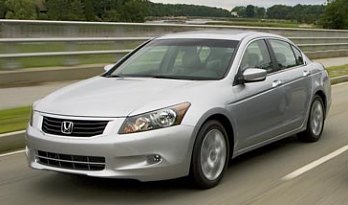
|
New Accord grows considerably in all
dimensions, so much that it is now classified as "large car" by EPA.
|
Size
matters in the United
States. They live in big houses, eat Big Mac, build big warships,
borrow big money and have big spending on their elections. As for
driving habits, they also prefer bigger cars and trucks. Feeling the
need to please American customers, since the late 1990s Honda started
building larger Accord for the America market and a smaller Accord for
Japan and Europe. As the two cars have too many differences, we had
better to split their reports into two. Now let us concentrate on the
American car, which has been renewed just recently.
The 8th generation Accord is again larger than the car it replaced. It
is some 117 mm longer, 32 mm wider, 21 mm taller and the wheelbase is
stretched by 60 mm. The 4930 mm length and 2800 mm wheelbase put it
clearly ahead of its arch-rival Toyota Camry, while an interior volume
of 120 cubic feet elevates it to the "large car" category of EPA, so
theoretically it competes with Chrysler 300, Ford Taurus (the previous
500), Toyota Avalon and Buick Lucerne. More shocking, the new Accord is
even larger than Honda's own flagship luxury car, Legend / Acura RL !
Of course, Honda has no intention to promote internal competition.
Mid-size cars are still the best selling segment in the USA, thus the
new Accord will continue to compete with Toyota Camry, Nissan Altima,
Hyundai Sonata, Chrysler Sebring, Saturn Aura and the recently renewed
Chevrolet Malibu. However, by far the strongest rival is Camry, which
overtook Accord to be the best selling car in the USA since 1997
(although Honda regained the title briefly in 2001). If it succeed to
beat Camry, it could generate a sales of 400,000 units a year in the
United States alone, plus another 200,000 units or so from the China
market ! By any standards this is a very profitable business.
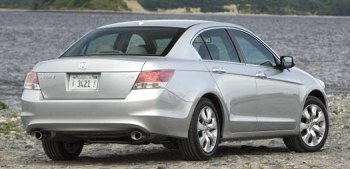
|
There are traces of BMW 5-Series in
its styling, but not dynamics, unfortunately.
|
But to get more customers, a good look
is very important.
Some people may find the new Accord looking upmarket because it copied
various design elements (say, the kickback C-pillars) from BMW
5-Series. Other people like us may accuse it for lacking originality.
Most people agree that the angular front end is too odd to appreciate
and the rear end design looks quite bland. Besides, the elevated bonnet
doesn't help to achieve a sleek appearance. It is designed to comply
with the new pedestrian safety regulation in Japan (similar to Europe)
because this car will be sold there as Honda Inspire. Seems quite
nonsense to me, as the sales volume of Inspire is negligible compare
with the American and Chinese market. Apparently, this design is not my
cup of tea, but fortunately neither is the current Toyota Camry. By
adopting boring designs, the Japanese is so kind to give the stylish
American cars like Malibu, Aura and 300 some space for survival.
In contrast, the interior is hard to fault. Although it doesn't possess
the quality feel of European cars (e.g. most plastics are grained but
hard ones), the dashboard is well designed to provide good ergonomics
and convenience. A LCD screen is mounted high in the middle to cause
less distraction from the road ahead. In dark color the environment is
quite cold, but the large windows and slim pillars provide excellent
view out. Benefited by the larger body, the cabin offers slightly more
front head room, shoulder room and rear legroom than the already roomy
outgoing car. It isn't as roomy as Chrysler 300 or Ford Taurus, but it
accommodates 3 large passengers at the back more comfortably than Camry.
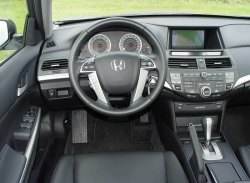 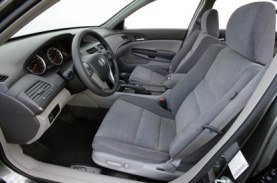
|
|
The new chassis employs more
high-strength steel (48% vs
39%) and stronger frame rail structure to boost 20 percent in torsional
rigidity. Needless to say, its crash worthiness is vastly improved and
more safety equipment becomes standard. The body's drag coefficient of
0.31 isn't remarkable, but it won't prevent the car to reach its
regulated top speed at 130 mph. Suspending the monocoque body is a pair
of double-wishbone up front (similar to the old car) and a new
multi-link rear setup composed of an upper wishbone, two lower links
and a toe-control link. It should return better ride and handling than
the old double-wishbone-based system. The new suspension geometry
results in higher roll centers, while the center of gravity of the
whole car is lowered by approximately 10 mm thanks to mounting the
powertrain and fuel tank lower. Both factors enhance cornering
stability. A new variable gear ratio steering should improve steering
precision.
With little surprise, the larger and stronger new Accord is more than
100 kg heavier than the old car. As American drivers are not willing to
sacrifice performance, Honda has to tune its 2.4-liter DOHC i-VTEC
four-cylinder engine to produce more punch. Now this engine has two
states of tune: the base engine produces 177 horsepower and 161 lb-ft
of torque; a high-output version employs variable back-pressure exhaust
and higher compression ratio to produce 190 horsepower and 162 lb-ft.
Both are more powerful than the 160 hp old engine while retaining the
smoothness (thanks to twin-balancer shafts) and tractability. The
rev-happy 190 hp engine is especially sweet to keen drivers when mated
with 5-speed manual gearbox, whose slick and short-throw gearchange is
one of the industry's bests.
At the upper end, the outgoing 240-horsepower 3.0-liter SOHC VTEC V6
has been replaced with a larger 3.5-liter SOHC i-VTEC V6 producing 268
horsepower and 248 lb-ft of torque. In terms of output, it is on a par
with the 3.5-liter Camry and Altima. In terms of refinement, it is
second to none. You might think enlarging from 3 liters to 3.5 liters
will bring a higher fuel consumption. On the contrary, the new Accord
V6 actually drinks slightly less fuel than the old car. This is due to
the cylinder deactivation technology (or VCM Variable Cylinder
Management as Honda calls) it adopted. The i-VTEC system is based on
the old cam-changing VTEC but with an additional function to deactivate
the valves and effectively shut down individual cylinders. This mean
the V6 can run on 3 or 4 cylinders at light load to save fuel, and
return to 6 cylinders to provide full power. To deal with the
unpleasant sound in 3-cylinder mode, it is equipped with anti-noise
control - which produce a 180-degree out-of-phase noise to cancel the
noise source - like the outgoing Honda Inspire.
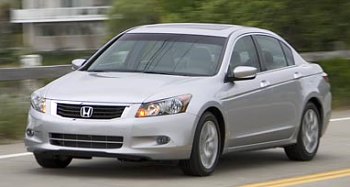
|
We expect a lot from the new Accord,
but it turns out to be not the car we expected.
|
However, the V6 Accord is not going to
match the equivalent
Camry and Altima for performance, because it is not only heavier but
also it partners with an old fashion 5-speed automatic transmission. In
Camry, you have a 6-speed automatic with manual mode (the Honda
transmission doesn't have manual override). In Altima, you can choose
between a CVT with 7 manual steps and a 6-speed manual gearbox. We
expect the Honda will take 6.6 seconds to go from 0-60 mph, half a
second slower than its rivals. It's not the end of the world, but it
washes out the driver's car image the old Accord established.
On the road, the new Accord displays a good balance between ride and
handling. Its ride quality is noticeably improved over the old car and
certainly better than the stiffly sprung Camry SE and Altima. Body roll
is also well suppressed in corners, so the suspension revision and
lower center of gravity is worthwhile. Most family car buyers will love
its smooth ride and lightweight controls (steering, gearchange and
clutch), but keen drivers will prefer Ford Fusion and Saturn Aura for
their firmer damping and higher agility. The Honda's variable gear
ratio steering is responsive (2.6 turns only from lock to lock) and
accurate, if not truly communicative. Grip and braking are just
average, obviously hampered by the extra weight it carries. Overall
speaking, we can't say the new Accord fun to drive.
No matter in dynamics, packaging, quality or styling, the new American
Accord does not set any new standards for the class. A competent
all-rounder ? Yes, but it falls short of our expectation.
|
| The
above report was last updated on 10 Nov
2007. All Rights Reserved. |
Accord Coupe
|
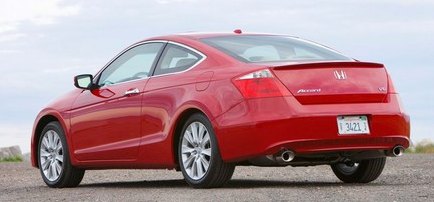
|
A beautiful design is half it takes a
coupe to succeed. What do you think about this ?
|
Does
the market still
demand mid-size front-wheel-drive coupes ? After a decade of recession,
this segment is getting momentum again. New comers like Alfa Romeo
Brera, Audi A5, Nissan Altima Coupe and the forthcoming Renault Laguna
Coupe add fuel to the fire, while traditional players like Peugeot 407
Coupe, Mitsubishi Eclipse, Toyota Camry Solara and Honda Accord Coupe
continue to present in the segment. Associating closely with a sedan
has advantages and disadvantages. On the positive side, it utilizes
high percentage of component sharing, thus saves a lot of money. On the
negative side, the coupe is difficult to establish its own character
and identity. You know, this segment is all about image.
In the case of Accord Coupe, from these photos you can see Honda did
tried to give it a different design. It said all body panels are
different from the sedan. It said the wheelbase has been shortened by
60 mm, the overall length reduced by 80 mm and the roof lowered by 44
mm in order to deliver a sportier profile. Besides, from B-pillar
rearward everything is different – for example, more stylish
taillights, faster rear window and sporty twin-exhaust. Nevertheless,
this car is still far from beautiful. Its biggest problem is a bonnet
and shoulder line too high, so it lacks the sleekness a coupe should
look. Moreover, the angular front end design is still an eyesore, no
matter in the sedan or coupe. When a coupe looks this ugly, it takes a
miracle to succeed.
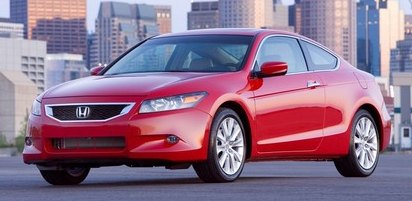
|
Another half of the formula for
success is a sporty driving experience. It lacks too.
|
Miracle doesn't happen in its cabin
either. The Accord Coupe
is called Accord Coupe instead of another name because it can't /
doesn't want to hide its close relationship with its sedan version. In
other words, the cabin is basically the same as the sedan, which is too
boring / grey / conservative / mass-production feeling for a coupe. I
can't see how it could attract young drivers. On the plus side, the
rear seats are roomy by coupe standard, although headroom could be
restricted for tall adults.
The coupe is powered by either the 190 hp 2.4-liter i-VTEC four-banger
or the 268 hp 3.5 VTEC V6. This V6 employs the old VTEC system instead
of
the sedan's i-VTEC, meaning it goes without cylinder deactivation, but
it produces no more power and torque. (So Honda seems telling us: if
you want to buy a coupe, don't bother about fuel consumption or
environmental impact ! What is this logic ?!) In the coupe, the V6
engine can be purchased together with a short-throw 6-speed manual
gearbox. This shortens 0-60 mph by half a second to around 6 seconds
flat.
Thanks to the double-wishbone front suspensions and adequate engine
mapping, torque steer is
negligible. But the front-wheel drive and
front-biased weight distribution result in moderate understeer when the
car hurries into corners. Obviously, the Accord Coupe is still very
much a
sedan in its nature. Honda should have worked harder to tighten its
handling and give it a handsome face. Now failing to excel in both
areas, the Accord Coupe has no reason to exist. |
| The
above report was last updated on 14 Nov
2007. All Rights Reserved. |
|
|